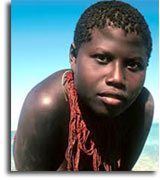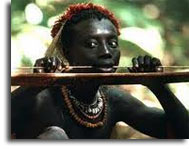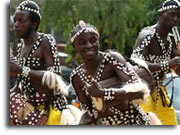Jarawa Tribes
The Jarawa are one of the four tribes in the Andamans which is a group of islands in the Indian Ocean. The Jarawa are hunters and gatherers and live on two large islands. They number between 200-400 which is a large number when compared to the other tribes in Andaman islands. They are nomadic, living in bands of 40-50 people.

Alcoholism, obesity, diabetes, and depression, are other ailments, which are now appearing as the other causes for decrease in their population.
Jarawa or Jarwa means "stranger" in the language of the Great Andamanese. They call themselves "Ya-eng-nga" which, means "human being".
History
The ancestors of the Jarawa and the other tribes of the Andaman Islands are thought to have been part of the first successful human migrations out of Africa. Several hundred thousand Indian settlers now live on the islands, vastly outnumbering the tribes.
Location
The Jarawas inhabit the west portion of south Andamans and Middle Andamans. It has three social territorial divisions as, Northern group, Central and Southern Group. The northern group inhabit the Kadamtala adjacent areas called 'Tanmad', the southern group inhabit tirur area called 'Boiab' and the central group inhabit the RK Nallah adjacent areas along the Andaman Truck Road area called 'Thidong'.
Place /Location (then and now) |
South Andamans, Middle Andamans |
Population |
bands of 40-50 people |
Languages spoken |
Andamanese |
Food |
wild boar, turtles and their eggs, crabs, fruits and honey |
Culture

'Towa' is most popular tool among the Jarawas which they use in cutting pork in pieces. It has a shape of an arrow with no stick but has a wide breadth of 4-6 inches. They keep Towa in their wiast guard known as 'tohe' in jarwa Langauge. Jarawa Language The sun (ehey), moon (taape), sky (pange), stars (chilope) and cloud (ethibithi) have their great role in the Jarawa myths and legends. The full moon is called 'utthutaape' and small moon is called 'poniya tappe'. The high tide is called 'chakte' while low tide is called 'chigia'
Encroachments into their territory is threatening their very existence.Outside intereaction expose them to new diseases for which they seem to have no immunity. Poachers are said to steal their game as well. Sexual exploitation of the Jarawa women has also been reported. Tourism has been a major threat of late for the Jarawas. Indigenous tribes are our heritage to be treasured and it remains our responsibility to help them sustain themselves in environments they have always lived in and not turn them into objects of tourist curiosity.
Occupation
The Jarawas who live in the rainforests hunt wild pigs, monitor lizards, fish and gather fruits and berries. Their lives are synchronised with the environment around them.
Food
As nomadic tribes who depend on hunting, fishing and gathering activities, their traditional food articles consist of wild boar, turtles and their eggs, crabs and other shore animals, fruits like jackfruit and honey..
Jarawa Dance



